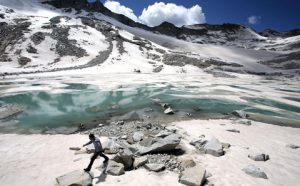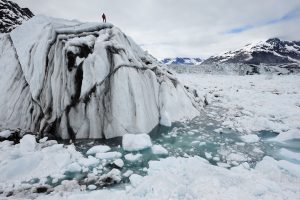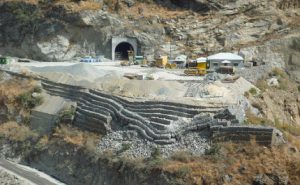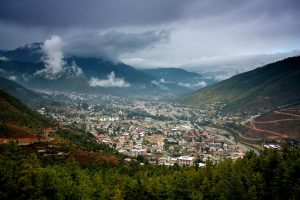Villagers in the harsh landscapes of northwestern Alaska face a formidable journey. Sea ice and permafrost, the frozen subsoil that makes the land hospitable to humans, are melting. Flooding and erosion are blighting lives.
Climate change has taken on very real dimensions for these ancient coastal communities with their ancient names – Unalakleet, Golovin, Teller – where temperatures have risen twice as fast as the global average over the past half century. As government interventions have failed to ward off the elements, 12 indigenous groups have decided they want to move. More may follow.
They are not alone. From the Sahel, where women already walk up to 25 kilometres a day to collect water, to the island atoll of Majuro, set to battle increasingly regular and destructive high tides that wash away houses and flood roads, climate change is challenging the durability of people’s homes. In the long-term, many will need to adapt, or seek new lives elsewhere.
As awareness of the potential scale of climate migration grows, an international network of lawyers is seeking to draft a treaty to help secure assistance for vulnerable groups.
Operating outside the UN system, the proposed Convention for Persons Displaced by Climate Change would see richer countries agree to give money to poorer countries, either to adapt homes so that people can stay in them as long as possible or to move communities in a planned way over time. It would also establish a framework for long-term discussion on the more fraught problem of rehoming whole nations lost to the sea. Importantly, signatories to the treaty would not be asked to commit to taking people from elsewhere.
A draft treaty is expected by the end of the year, after which the team will start trying to persuade states to sign up.
Climate migration – or displacement – has drawn increasing interest in the past five years as experts have piled into the field to analyse the likely human impacts of rising sea levels, desertification, glacial lake outbursts and more. Projections of the scale of movement still vary wildly, ranging from tens of millions to the oft-quoted estimate of Oxford academic Norman Myers who puts it as high as 250 million by 2050 (or one in every 36 people on the planet). But a clearer view of the likely impacts of such human migration is slowly emerging.
While the dramatic fate awaiting Pacific island nations set to be wiped off the map as sea-levels rise has understandably seized headlines, scholars now emphasise that most displacement will happen within countries. Few people are likely to cross international borders. As a 2007 report from UNDP puts it, “The simplistic image of a coastal farmer being forced to pack up and move to a rich country is not typical.” Most of the burden will be borne locally.
That does not make it an easy problem to tackle. Conflict is expected as migration brings competition for land and water into sharper focus. Governments, disproportionately in poor countries, will have to find ways of protecting or rehousing vulnerable communities. And, for the nations that are rendered uninhabitable, whole peoples will have to find host countries willing to take them, raising a host of thorny legal questions: is an underwater country still a state, for instance? What happens to its fishing rights? And what’s the legal status of its people?
A climate migration treaty
So how can a treaty help? Australian lawyer David Hodgkinson, an aviation attorney by trade, is leading the project. The point, he says, is that climate displacement is a global issue: even if most migrants don’t cross international borders, the impacts will be transnational. “Climate change displacement in one way or another will affect every state,” he says, whether because of internal migration or because they’re being asked to cough up funds to help other countries.
Existing climate and refugee law fails adequately to provide for those displaced by global warming, says Hodgkinson. And, while “piecemeal efforts” are under way – researchers are helping Alaskan groups plan for relocation, for instance –something rather more coordinated is needed, he says. In short, the world needs to start talking.
But isn’t it already? Transferring money for adaptation from the rich to poor world already forms part of UN negotiations, and developed countries have promised to provide US$100 billion per year by 2020 for adaptation and mitigation efforts. Why start a separate conversation?
For Hodgkinson’s team, forging a specific treaty on the narrower issue of climate displacement represents an opportunity to break with stalled attempts to agree a wider deal on climate change. “We recognise that treaty making is inherently difficult, particularly with regard to climate change. But I do think one way forward is to break the problem up into pieces and somehow make it a little more manageable.”
Even if he’s right and efforts on climate displacement prove more fruitful than the UN’s more ambitious – and troubled – climate journey, there are severe challenges ahead.
First are broad human welfare issues linked to large numbers of people uprooting from long-term homes and seeking new places to live – how this can be done without impinging on other people’s territorial rights, for instance.
Then there’s the risk governments will use climate change as an excuse to move people they want to move anyway, or simply make bad judgments. In the west of China, for instance, large numbers of herders moved off the grasslands in the name of environmental protection – so-called “eco migrants” – have been stranded in cities with no livelihood or social networks, while the impact on grassland preservation has been negligible.
Hodgkinson readily admits his treaty will have limits in the face of such problems: “I’m sure that governments will make those sorts of decisions and I’m sure that in some instances climate change will be used as an excuse to achieve non-climate change related objectives. There’s no question but that there will be problems and problems that a treaty won’t be able to guard against.”
The money problem
Perhaps the biggest challenge of all, however, is funding. The developed world is already falling far short of its promises on adaptation finance, and enthusiasm for footing the bill for reinforcing foreign homes may weaken further as climate costs at home mount: Hurricane Sandy alone cost America up to US$50 billion, according to catastrophe analyst Eqecat, and extreme weather events are predicted to increase. Persuading countries to commit more than they already have will be a tough sell.
“In that regard, it’s sometimes hard not to be pessimistic generally about the climate-change problem,” says Hodgkinson. “Generally it may be that, notwithstanding the global nature of the problem, states do retreat into ever more narrow forms of self interest and, understandably enough, look after their own people. The consequences of that are understandable, but may well be quite alarming.”
One aspect of the migration conversation makes him more cheerful, however – unlike mitigation targets, CDM schemes and other more clinical aspects of the climate discussion, displacement is easy to describe and appreciate: “People can understand it, because we all have homes. Families on the move, people needing new homes – it’s a very human problem. And my experience as a lawyer has been that, when people can intuitively understand a problem, that can assist in finding solutions.”
There’s something else. Hodgkinson came to climate change through his career as an aviation lawyer, where he has seen first-hand the “intractable” knots around legislating on airplane emissions – shown most recently by the EU’s stalled attempt to include international flights in its carbon trading scheme. Dwelling for a moment on the difficulties of that sector, his voice brightens: “Gee, climate displacement might not be so difficult after all.”





